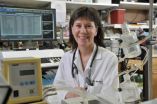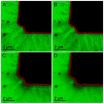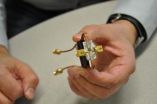(Press-News.org) Although the time and cost of sequencing an entire human genome has plummeted, analyzing the resulting three billion base pairs of genetic information from a single genome can take many months.
In the journal Bioinformatics, however, a University of Chicago-based team—working with Beagle, one of the world's fastest supercomputers devoted to life sciences—reports that genome analysis can be radically accelerated. This computer, based at Argonne National Laboratory, is able to analyze 240 full genomes in about two days.
"This is a resource that can change patient management and, over time, add depth to our understanding of the genetic causes of risk and disease," said study author Elizabeth McNally, MD, PhD, the A. J. Carlson Professor of Medicine and Human Genetics and director of the Cardiovascular Genetics clinic at the University of Chicago Medicine.
"The supercomputer can process many genomes simultaneously rather than one at a time," said first author Megan Puckelwartz, a graduate student in McNally's laboratory. "It converts whole genome sequencing, which has primarily been used as a research tool, into something that is immediately valuable for patient care."
Because the genome is so vast, those involved in clinical genetics have turned to exome sequencing, which focuses on the two percent or less of the genome that codes for proteins. This approach is often useful. An estimated 85 percent of disease-causing mutations are located in coding regions. But the rest, about 15 percent of clinically significant mutations, come from non-coding regions, once referred to as "junk DNA" but now known to serve important functions. If not for the tremendous data-processing challenges of analysis, whole genome sequencing would be the method of choice.
To test the system, McNally's team used raw sequencing data from 61 human genomes and analyzed that data on Beagle. They used publicly available software packages and one quarter of the computer's total capacity. They found that shifting to the supercomputer environment improved accuracy and dramatically accelerated speed.
"Improving analysis through both speed and accuracy reduces the price per genome," McNally said. "With this approach, the price for analyzing an entire genome is less than the cost of the looking at just a fraction of genome. New technology promises to bring the costs of sequencing down to around $1,000 per genome. Our goal is get the cost of analysis down into that range."
"This work vividly demonstrates the benefits of dedicating a powerful supercomputer resource to biomedical research," said co-author Ian Foster, director of the Computation Institute and Arthur Holly Compton Distinguished Service Professor of Computer Science. "The methods developed here will be instrumental in relieving the data analysis bottleneck that researchers face as genetic sequencing grows cheaper and faster."
The finding has immediate medical applications. McNally's Cardiovascular Genetics clinic, for example, relies on rigorous interrogation of the genes from an initial patient as well as multiple family members to understand, treat and prevent disease. More than 50 genes can contribute to cardiomyopathy. Other genes can trigger heart failure, rhythm disorders or vascular problems.
"We start genetic testing with the patient," she said, "but when we find a significant mutation we have to think about testing the whole family to identify individuals at risk."
The range of testable mutations has radically expanded. "In the early days we would test one to three genes," she said. "In 2007, we did our first five-gene panel. Now we order 50 to 70 genes at a time, which usually gets us an answer. At that point, it can be more useful and less expensive to sequence the whole genome."
The information from these genomes combined with careful attention to patient and family histories "adds to our knowledge about these inherited disorders," McNally said. "It can refine the classification of these disorders," she said. "By paying close attention to family members with genes that place then at increased risk, but who do not yet show signs of disease, we can investigate early phases of a disorder. In this setting, each patient is a big-data problem."
Beagle, a Cray XE6 supercomputer housed in the Theory and Computing Sciences (TCS) building at Argonne National Laboratory, supports computation, simulation and data analysis for the biomedical research community. It is available for use by University of Chicago researchers, their collaborators and "other meritorious investigators." It was named after the HMS Beagle, the ship that carried Charles Darwin on his famous scientific voyage in 1831.
INFORMATION:
The National Institutes of Health and the Doris Duke Charitable Foundation funded this study. Additional authors include Lorenzo Pesce, Viswateja Nelakuditi, Lisa Dellefave-Castillo and Jessica Golbus of the University of Chicago; Sharlene Day of the University of Michigan; Thomas Coppola of the University of Pennsylvania; and Gerald Dorn of Washington University.
Whole genome analysis, stat
Supercomputer dramatically accelerates rapid genome analysis
2014-02-19
ELSE PRESS RELEASES FROM THIS DATE:
Study shows in vivo endomicroscopy improves detection of Barrett's esophagus-related neoplasia
2014-02-19
DOWNERS GROVE, Ill. – February 19, 2014 – New research shows that the addition of confocal laser endomicroscopy to high-definition white-light endoscopy enables improved real-time endoscopic diagnosis of Barrett's esophagus dysplasia (neoplastic tissue) by using targeted biopsies of abnormal mucosa to reduce unnecessary mucosal biopsies and potentially reduce costs. It may also positively influence patient care by changing the plan for immediate endoscopic management. The study appears in the February issue of GIE: Gastrointestinal Endoscopy, the monthly peer-reviewed scientific ...
RXTE reveals the cloudy cores of active galaxies
2014-02-19
VIDEO:
Zoom into the cloudy heart of an active galaxy. This animation shows an artist's rendition of the cloudy structure revealed by a study of data from NASA's Rossi X-Ray Timing...
Click here for more information.
Picture a single cloud large enough to span the solar system from the sun to beyond Pluto's orbit. Now imagine many such clouds orbiting in a vast ring at the heart of a distant galaxy, occasionally dimming the X-ray light produced by the galaxy's monster black ...
NuSTAR helps untangle how stars explode
2014-02-19
For the first time, an international team of astrophysicists, including Lawrence Livermore National Laboratory scientists, have unraveled how stars blow up in supernova explosions.
Using NASA's Nuclear Spectroscopic Telescope Array (NuSTAR) – a high-energy X-ray observatory - the international collaboration created the first-ever map of radioactive material in a supernova remnant, named Cassiopeia A, or Cas A for short. The findings reveal how shock waves likely rip apart massive dying stars, and ultimately end their lives.
A supernova is the cataclysmic death of a ...
REACT clinical trial supports new approach of accelerated treatment for Crohn's disease
2014-02-19
The final results from an international clinical trial involving nearly 2,000 patients with Crohn's disease support the use of a new management strategy referred to as accelerated step-care as a best practice for the care of active Crohn's disease. The REACT (Randomized Evaluation of an Algorithm for Crohn's Treatment) study, led by Robarts Clinical Trials at Western University (London, Canada) provides valuable new insights for community gastroenterologists which should benefit patients. The results of the study will be presented at the European Crohn's and Colitis Organisation ...
ORNL microscopy system delivers real-time view of battery electrochemistry
2014-02-19
OAK RIDGE, Tenn., Feb. 19, 2014 -- Using a new microscopy method, researchers at the Department of Energy's Oak Ridge National Laboratory can image and measure electrochemical processes in batteries in real time and at nanoscale resolution.
Scientists at ORNL used a miniature electrochemical liquid cell that is placed in a transmission electron microscope to study an enigmatic phenomenon in lithium-ion batteries called the solid electrolyte interphase, or SEI, as described in a study published in Chemical Communications.
The SEI is a nanometer-scale film that forms ...
Many Texans struggling to pay for health service as Affordable Care Act is about to launch
2014-02-19
HOUSTON – (Feb. 19, 2014) – Many Texans were struggling to pay for basic health services on the eve of the launch of the Affordable Care Act's Health Insurance Marketplace, according to a report released today by Rice University's Baker Institute for Public Policy and the Episcopal Health Foundation. The report also found that even those with health insurance reported dissatisfaction with the cost and availability of services. Most Texans expect more of the same in 2014.
The Health Reform Monitoring Survey (HRMS)-Texas report is based on the HRMS, a national project that ...
Molecular aberration signals cancer
2014-02-19
Several scientists, including one at Simon Fraser University, have made a discovery that strongly links a little understood molecule, which is similar to DNA, to cancer and cancer survival.
EMBO Reports, a life sciences journal published by the European Molecular Biology Organization, has just published online the scientists' findings about small non-coding RNAs.
While RNA is known to be key to our cells' successful creation of proteins, the role of small non-coding RNAs, a newly discovered cousin of the former, has eluded scientific understanding for the most part. ...
Cell therapy shows remarkable ability to eradicate cancer in clinical study
2014-02-19
NEW YORK, February 19, 2014 — Investigators from Memorial Sloan Kettering Cancer Center have reported more encouraging news about one of the most exciting methods of cancer treatment today. The largest clinical study ever conducted to date of patients with advanced leukemia found that 88 percent achieved complete remissions after being treated with genetically modified versions of their own immune cells. The results were published today in Science Translational Medicine.
"These extraordinary results demonstrate that cell therapy is a powerful treatment for patients who ...
LGBT youth face greater cancer risks, CCNY-led study
2014-02-19
A new study led by City College of New York psychologist Margaret Rosario found that youths of same-sex orientation are more likely to engage in behaviors associated with cancer risk than heterosexuals. The peer-reviewed findings appear in the February 2014 issue of the American Journal of Public Health.
Titled "Sexual Orientation Disparities in Cancer-Related Risk Behaviors of Tobacco, Alcohol, Sexual Behaviors, and Diet and Physical Activity: Pooled Youth Risk Behavior Surveys," the study pooled YRBS (Youth Risk Behavior Survey) data from 2005 and 2007. The YRBS is ...
Using holograms to improve electronic devices
2014-02-19
RIVERSIDE, Calif. (http://www.ucr.edu) — A team of researchers from the University of California, Riverside Bourns College of Engineering and Russian Academy of Science have demonstrated a new type of holographic memory device that could provide unprecedented data storage capacity and data processing capabilities in electronic devices.
The new type of memory device uses spin waves – a collective oscillation of spins in magnetic materials – instead of the optical beams. Spin waves are advantageous because spin wave devices are compatible with the conventional electronic ...
LAST 30 PRESS RELEASES:
On-demand upgraded recycling of polyethylene and construction of sustainable multifunctional materials based on the "LEGO" strategy
New "Stomata in-sight" system allows scientists to watch plants breathe in real-time
Anorexia nervosa may result in long-term skeletal muscle impairment
Narrative-based performance reviews deemed fairest by employees
New insights reveal how advanced oxidation can tackle emerging water pollutants
New review shows how biomass can deliver low-carbon gaseous fuels at scale
Climate change is quietly rewriting the world’s nitrogen cycle, with high stakes for food and the environment
Study finds SGLT-2 inhibitors linked to lower risk of diabetic foot nerve damage
Microbes may hold the key to brain evolution
Study examines how the last two respiratory pandemics rapidly spread through cities
Gender stereotypes reflect the division of labor between women and men across nations
Orthopedics can play critical role in identifying intimate partner violence
Worms as particle sweepers
Second spider-parasitic mite described in Brazil
January 2026 issues of APA journals feature new research on autism, pediatric anxiety, psychedelic therapy, suicide prevention and more
Private equity acquired more than 500 autism centers over the past decade, new study shows
New cervical cancer screening guidelines from the US Department of Health and Human Services
Estimated burden of COVID-19 illnesses, medical visits, hospitalizations, and deaths in the US from October 2022 to September 2024
Smartphone use during school hours by US youth
Food insecurity and adverse social conditions tied to increased risk of long COVID in children
Earliest, hottest galaxy cluster gas on record could change our cosmological models
Greenland’s Prudhoe Dome ice cap was completely gone only 7,000 years ago, first GreenDrill study finds
Scientific validity of blue zones longevity research confirmed
Injectable breast ‘implant’ offers alternative to traditional surgeries
Neuroscientists devise formulas to measure multilingualism
New prostate cancer trial seeks to reduce toxicity without sacrificing efficacy
Geometry shapes life
A CRISPR screen reveals many previously unrecognized genes required for brain development and a new neurodevelopmental disorder
Hot flush treatment has anti-breast cancer activity, study finds
Securing AI systems against growing cybersecurity threats
[Press-News.org] Whole genome analysis, statSupercomputer dramatically accelerates rapid genome analysis





